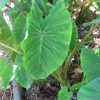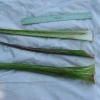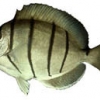Use As Food
Makes poi of good quality.
Distribution
Planted in a few scattered locations, under māla (upland) or lo‘i (wetland) culture.
General Characteristics
Medium in height to tall, well spreading, maturing in about 12 months, producing from 5 to 10 ‘ohā; distinguished by very light colored Hā (Petiole) with indistinct reddish-purple stripes.
Ha (Petiole)
65 to 90 cm. long, shading from light green to yellowish-green toward top (apex) with a few indistinct, more or less interrupted reddish-purple stripes more prominent toward the kōhina (base), conspicuously reddish-purple at apex, an area of white for 3 to 5 cm. above the kōhina (base), with inconspicuous faint pink to whitish lihi (stem edge).
Lau or Lu'au(Leaf Blade)
40 to 50 cm. long, 30 to 35 cm wide, 30 to 40 cm. from tip to base of sinus (māwae), arrow head shaped, thin in texture, drooping, dark green with bluish cast; piko purple; veins purple on lower surface of round leaf section (lobes); round leaf section (lobes) acute with narrow lihi māwae (sinus).
'I'o kalo (Corm)
Flesh white with yellowish fibers; skin white to cream-colored.
Pua (Flower)
Remarks
This variety seems to be fairly resistant to soft rot. It is the lightest in color of the striped taros; light colors for the stem and the colors on the stem. The reddish-purple stripes are minute fleckings arranged in definite, narrow lines.









